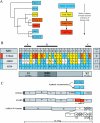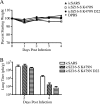Mechanisms of zoonotic severe acute respiratory syndrome coronavirus host range expansion in human airway epithelium
- PMID: 18094188
- PMCID: PMC2258931
- DOI: 10.1128/JVI.02041-07
Mechanisms of zoonotic severe acute respiratory syndrome coronavirus host range expansion in human airway epithelium
Abstract
In 2003, severe acute respiratory syndrome coronavirus (SARS-CoV) emerged and caused over 8,000 human cases of infection and more than 700 deaths worldwide. Zoonotic SARS-CoV likely evolved to infect humans by a series of transmission events between humans and animals for sale in China. Using synthetic biology, we engineered the spike protein (S) from a civet strain, SZ16, into our epidemic strain infectious clone, creating the chimeric virus icSZ16-S, which was infectious but yielded progeny viruses incapable of propagating in vitro. After introducing a K479N mutation within the S receptor binding domain (RBD) of SZ16, the recombinant virus (icSZ16-S K479N) replicated in Vero cells but was severely debilitated in growth. The in vitro evolution of icSZ16-S K479N on human airway epithelial (HAE) cells produced two viruses (icSZ16-S K479N D8 and D22) with enhanced growth on HAE cells and on delayed brain tumor cells expressing the SARS-CoV receptor, human angiotensin I converting enzyme 2 (hACE2). The icSZ16-S K479N D8 and D22 virus RBDs contained mutations in ACE2 contact residues, Y442F and L472F, that remodeled S interactions with hACE2. Further, these viruses were neutralized by a human monoclonal antibody (MAb), S230.15, but the parent icSZ16-S K479N strain was eight times more resistant than the mutants. These data suggest that the human adaptation of zoonotic SARS-CoV strains may select for some variants that are highly susceptible to select MAbs that bind to RBDs. The epidemic, icSZ16-S K479N, and icSZ16-S K479N D22 viruses replicate similarly in the BALB/c mouse lung, highlighting the potential use of these zoonotic spike SARS-CoVs to assess vaccine or serotherapy efficacy in vivo.
Figures







References
-
- Cello, J., A. V. Paul, and E. Wimmer. 2002. Chemical synthesis of poliovirus cDNA: generation of infectious virus in the absence of natural template. Science 2971016-1018. - PubMed
-
- Chinese SARS Molecular Epidemiology Consortium. 2004. Molecular evolution of the SARS coronavirus during the course of the SARS epidemic in China. Science 3031666-1669. - PubMed
-
- Deming, D., T. Sheahan, M. Heise, B. Yount, N. Davis, A. Sims, M. Suthar, J. Harkema, A. Whitmore, R. Pickles, A. West, E. Donaldson, K. Curtis, R. Johnston, and R. Baric. 2006. Vaccine efficacy in senescent mice challenged with recombinant SARS-CoV bearing epidemic and zoonotic spike variants. PLoS Med. 3e525. - PMC - PubMed
Publication types
MeSH terms
Substances
Grants and funding
LinkOut - more resources
Full Text Sources
Medical
Miscellaneous

